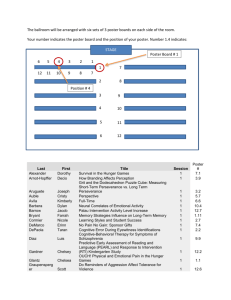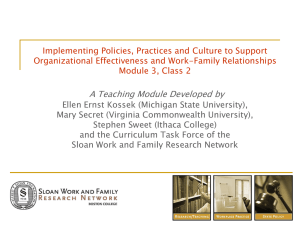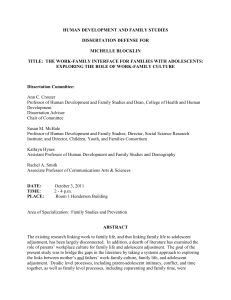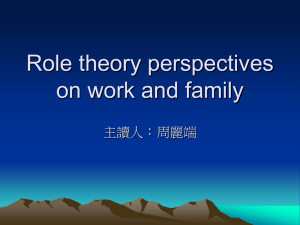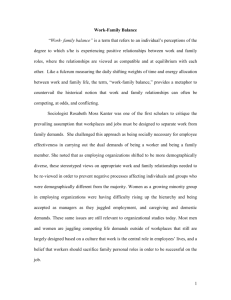Document 10802698
advertisement
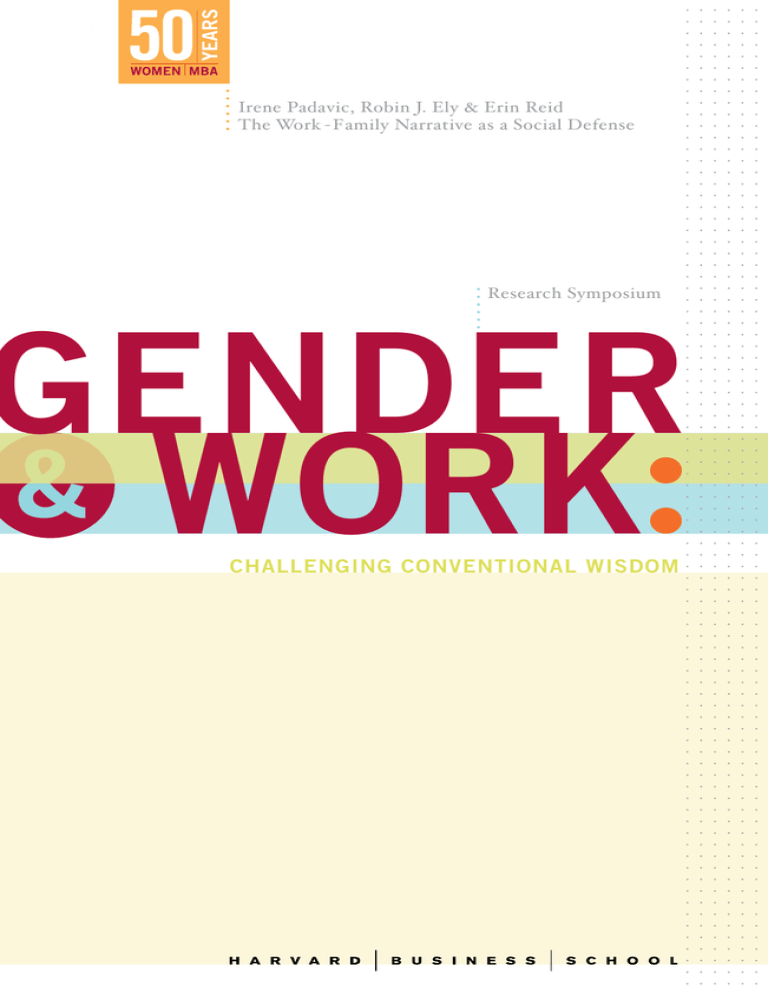
1 Irene Padavic, Robin J. Ely & Erin Reid The Work - Family Narrative as a Social Defense Research Symposium Gender & work Challenging Conventional Wisdom 2 3 work / family r e d n eG krow & ©2013 President & Fellows of Harvard College 4 WORK / FAMILY The Work-Family Narrative as a Social Defense Irene Padavic Robin J. Ely Erin Reid Florida State University Harvard Business School Boston University A widely-accepted explanation for women’s stalled advancement into senior professional positions is that women’s obligations to their families conflict with these jobs’ long hours, and the widely-championed solution has been policies designed to mediate this work-family conflict. Yet the success of such policies has been uneven, at best (Bailyn, 2006; Blair-Loy, 2003; Blair-Loy and Wharton, 2002 and 2004; Briscoe and Kellogg, 2011; Clarkberg and Moen, 2001; Glass, 2004; Judiesch and Lyness, 1999; Stone, 1997; Webber and Williams, 2008). Taking a psychodynamic systems-perspective on organizations, we offer one explanation for the persistence of the belief in work-family solutions in the face of this lack of success. We suggest that organizations use the work-family narrative and attendant work routines and policies as an unconscious “social defense.” A social defense is a set of organizational arrangements, including structures, work routines, and narratives, that functions to protect members from having to confront disturbing emotions stemming from internal psychological conflicts produced by the nature of the work (Petriglieri & Petriglieri, 2010:47; see also Jacques, 1955; Long, 2006; Menzies, 1960). We draw on a case study of a professional service firm to develop theory about links among women professionals’ advancement, the work-family discourse, and the psychodynamic systems-perspective on organizations, which has been gaining renewed prominence among organizational researchers (Long, 2006), although it has not yet been applied to the work-family dilemma. We propose that organizations—supported and reinforced by cultural beliefs about intensive mothering (Hays, 1996)—may rely on the work-family narrative as an explanation for women’s blocked mobility partly because it diverts attention from the broader problem of a long-hours work culture among professionals. The readily available work-family narrative allows firms and their members to avoid this reality and the anxieties it creates by projecting the problem exclusively onto women and by projecting the image of a successful employee exclusively onto men. Ironically, this focus leads to accommodation policies (such as moving to part time) that do little to help women and often hurt them. Meanwhile, the larger problem remains unaddressed and unacknowledged, penalizing all employees and limiting firms’ ability to accomplish their primary tasks. We draw on interview data to speculate about why the firm’s leaders and its women and men employees alike found the work-family narrative so singularly compelling; the main reason, we conclude, is that it allowed them to sidestep aspects of their work that aroused personal distress. Work-family is a particularly effective diversion because it is congruent with cultural trends, it affirms women’s and men’s personal “choices,” and it requires no upheaval of existing organizational practices. Our research is both inductive and deductive. We did not enter our research site with a hypothesis about the organization’s social defenses. Rather, we arrived at it over time, inductively, upon observing a series of disconnects at several levels as we collected data, analyzed it, 5 WORK / FAMILY and provided feedback. Upon observing these disconnects, we proceeded deductively by taking a psychodynamic systems-perspective on our data to further develop the analysis. Our study had been instigated at the request of firm leaders, who sought professional advice about how to stem women’s high rates of turnover in the associate ranks and increase their promotion rates to partner. We agreed to consult to the firm on these issues, and the firm gave us permission to collect data for research purposes. Although virtually all participants pointed to work-family conflict as the reason women quit or failed to make partner, our analysis showed women felt no greater distress than men over long work hours and work-family conflict. Both sexes were equally (and highly) dissatisfied on these dimensions, revealing a disconnect between the facts and the firm’s problem-definition. The second disconnect was the fact that a key “presenting problem,” to use psychological language, was the differential turnover rate, when in fact, there was no difference: company records indicate that women and men had quit at the same rate for at least the preceding three years. The third and final disconnect was firm leaders’ negative reaction to the analyses and proposed interventions. They had requested an analysis of the firm’s organizational culture; yet upon hearing that the gender problem was only a piece of a larger work-management problem and that the solution would involve a change in work practices that transcended workfamily accommodations, they rejected the analysis on grounds that it did not focus explicitly on women. Leaders’ apparent wish to retain their original assessment—that gender was the firm’s primary HR problem, that the nature of the gender problem was women’s difficulty balancing work and family, and that men were largely immune to such difficulties—required a rejection of evidence on the part of evidence-driven analysts, which we found notable. This set of disconnects among the presenting problem, the evidence, and the reactions led us to our research question: why does work-family persist as the dominant narrative and intervention strategy in organizations, given its uneven success in advancing women’s careers? What explains its resilience? In this paper, we draw on analytic insights from psychodynamic systems theory to consider the basis for participants’ conviction that women’s family lives were the main obstacle to women’s advancement. We use this case study more broadly to suggest that companies’ growing recognition of a “gender problem” and the currently popular focus on work-family issues to address it (Ramarajan, McGinn, and Kolb, 2012) help explain why women professionals’ advancement prospects have stalled. If the gender problem is in fact a byproduct of pervasive overwork among professionals, then the solution to women’s stalled progress will lie outside of the confines of the work-family domain; continuing to generate policy initiatives in that domain will not address the problem, and the underlying issues will remain. We also use this case study as a springboard for developing theory about why companies as well as the broader culture are so attracted to work-family as an explanation. Setting and Method The company we studied is a mid-sized global consulting firm employing between one and two thousand people in its worldwide offices. Like other professional service firms, it is male-dominated, particularly at senior levels, with men constituting about 63 percent of junior associates, 70 percent of associates, 77 percent of senior associates, and 90 percent of partners. The authors and members of the consulting team conducted interviews with over 100 women and men from all professional ranks. Most interviews were face-to-face on the premises, although some were in other venues, and interviews with overseas employees and a few others were conducted via telephone. All interviews were tape-recorded and transcribed. 6 WORK / FAMILY Results We begin by recounting the official story of female under-representation at the top. Partners indicted work-family issues, and this account filtered down the ranks. According to one partner: We have great intentions and I think pure intentions, genuine intentions, about getting the best involved regardless of gender, race, creed, religion, what have you. I frame it in the following way. What do I want people to worry about when they wake up first thing in the morning? For Business Development people, I want them to worry about business development. For project managers, I want them to worry about the project. Women are the Project Manager in the home, so it is hard for them to spend the necessary time, energy, and effort to be viewed here as senior leaders. Men and women associates, too, endorsed variations on this explanation. As one woman said: “Do women face particular challenges here? Not because they’re women but because their laundry list is longer than men’s.” Yet our interviews revealed several reasons to question whether the work-family narrative was the firm’s key human resource problem. Our data indicated that rather than work-family, the key HR problem was long hours. The organizational culture created unnecessarily long hours because of a culture of over-selling and over-delivery, and while the effects were more negative for women, men were equally unhappy, and indeed, equally likely to quit. We now turn to details of this claim. Although hours are long industry-wide, the organizational culture in this firm exacerbated the problem in two ways: overselling and over-delivery. Regarding the former, the sentiments of this interviewee were echoed by many: Some partners promise the client the moon without even thinking about what it means for their team. “We’ll give you X, Y and Z and we’ll do it all in half the time that you think it should take.” “Sure,” says the client! “Sign me up!” The culture also valorized over-delivery, priding itself on delivering “110 percent” to clients and offering “smart” solutions to clients’ problems. Associates went along with overdelivery and overwork partly to stand out as stars in a pool of highly-qualified people: We do these crazy slide decks that take hours and hours of work. It’s this attitude of, “I’m going to kill the client with a 100-slide deck.” But the client can’t use all that! People do it so others on the team will see they’re smart. Average weekly hours for women and men were 60 to 65, although quite a few claimed to regularly work 70 hours or more, and interviewees of both sexes noted hours as a problem. One woman recited her immediate supervisor’s admonition: I was told “You’re a big whiner.” I am like, I work so hard here! My people work so hard! Half way through that case I had them write down everything that we’d been asked to do and put hours alongside so that I can go to the senior managers and say: “It is physically impossible, even if these people didn’t sleep, to get everything you wanted done.” Another: Success and rewards are given to those who are always on. It makes me want to scream when I see emails at 3AM and senior leaders praising that person for their hard work. Leaders have a tendency to not be good about preventing work from taking over life. They swoop in and blow up what a team’s been doing instead of being connected earlier so no one has to work weekends. 7 WORK / FAMILY Men and women were interchangeable on this score. Indeed, the vast majority of fathers reported that work hours and travel requirements were difficult, as did most single and childless men. Here are a few comments about long hours and project mismanagement: There’s a correlation between success and the willingness to just put everything else aside and do a ton of work. People here are probably doing 14, 15 hours of work a day. Pretty much just working and sleeping during the week. They sleep 6 hours a night or less. I try to sleep more than that. It’s funny. Your ability to get by on little sleep is a necessary skill set. One senior associate described how he believed consultants should be “lying awake at night thinking about, ‘Man, what are we going to do in this meeting tomorrow?’” Another man echoed this view: We’re on our Blackberries. We’re thinking about our work 24/7. I mean maybe you tune out for a little while here and there, but people [at this firm] work all the time. All the time. You wake up at night, you’re dreaming about it. The first thing you do when you wake up is you pick up your Blackberry. Fathers, in particular, found it difficult to achieve a satisfying work-family balance: Last year was hard with my 105 flights. I was feeling pretty fried. I’ve missed too much of my kids’ lives. One man perceived little help with trying to mesh work demands with his family: Frankly, it’s sink or swim, and the attitude is, “So why don’t you just go swim? If you sink then that’s too bad. We like you. You’re a nice guy, but that’s just the way it is.” People were sympathetic and empathetic and open to having conversations. But the actual action, follow-up, was near zero. Our results showed that women and men were equally likely to say work interfered with their family lives, contrary to the organizational belief. This finding corroborates research indicating that professional men increasingly seek to spend more time with families and less time at work (Glavin, Schieman, and Reid, 2011; Milkie et al., 2004). According to one man we interviewed: I was traveling 3 days a week and seeing my children once or twice a week for 45 minutes before they went to bed. Saturday came, and I couldn’t go to my son’s soccer game. He burst into tears. I wanted to quit then and there. The solution for many was to leave. According to a father of three, whose wife was not in the labor force: I wouldn’t characterize myself as unhappy. It’s more overworked, and under-familied. If I were a betting man, I’d bet that a year from now I’m working somewhere else. And a year later, he was. Contrary to belief, there was no statistically significant difference between women’s and men’s quit rates; the annual rate hovered around 25% for both sexes. The Consequences of the Work-Family Narrative The outcome of the work-family narrative was a firm-wide focus on women, which had at least four negative consequences. First, it led to “ask-for-them-if-you-need-them” accommodations, which women were far more likely than men to take and which removed them from the fast-track, as other research has shown is typical (Judiesch & Lyness, 1999; Stone, 2007; Webber & Williams, 2008). Switching away from client-facing roles was common, for example almost 20% of women partners compared to 10% of men held completely internal-facing, administra- 8 WORK / FAMILY tive roles, throwing a road block in the path to real power. Part-time work was also common. Although ineffective—one woman said it meant working around the clock anyway—it removed women from the fast-track. Add to that the experience of not being taken seriously after having taken accommodations, which several women reported, and the stage is set for further limits on women’s career advancement. The second outcome was that the work-family narrative reified the notion that conflicting requirements of motherhood and the job meant women can’t handle the fast track. According to one man: It’s just basic math, right? So you take 100 people. Fifty are women and 50 are men. Twenty-five of the women are going to have kids and not want to work. Twenty-five of the women are going to have kids and might want to work, but won’t want to travel every week and live the lifestyle that consulting requires of 60 or 70 hour weeks. In his calculation, out of 50 women, all have children, and none is able to meet the requirements of the job. This unrealistic picture is the extreme version of the pervasive narrative: motherhood means women are inadequate to the task and explains their relative lack of success. Note how after being introduced (“50 are men”), men never appear again in the narrative. It is a work-family-balance problem, and it is women’s problem, not men’s. If men took accommodations at rates comparable to women (and they do not), doing so would no longer confirm the notion of women’s inability to do the job without assistance. Thus, the work-family narrative perpetuates the sense that women are unable to meet job demands. Yet some women are successful in this firm. How does the work-family narrative include that storyline? It doesn’t, and this is the third consequence of the work-family narrative. Senior women with children were labeled bad managers, bad mothers, or both, a terrible price to pay and one that can diminish ambition among women who witness such labeling. Regarding managing, women partners were criticized more harshly. Men with a reputation for “killing” their teams got a pass, while working for a woman who kills teams was a nightmare. Compare these assessments interviewees offered: He kills his people, but it’s a great project. She’s known for blowing up her teams. She actually is a bitch. Women partners were not merely bad managers; they also were bad mothers. We heard not one positive comment about women partners as mothers. These reputations meant women partners were invalidated as role models, further discouraging junior women from aspiring to “have it all”— by which we mean being a mother who holds a high-powered professional job. A junior woman told us the following about a woman partner she worked for: She tells a story she thinks is funny about how her kid was surprised when she picked him up from school. He said, “I’m so honored that you came to get me.” But I’m appalled by that story! That is not who I want to be! A junior man had a similar criticism: One of the people I’ve worked with a whole lot has two kids under the age of seven. She is travelling 4-5 days a week . . . . She disappears at 5:00 to have dinner and tuck her kids in, but then she gets back online and works all night, and then she’s up again at 4:00. That’s a model of what I don’t want. While it’s unclear how she can travel five days a week and also be home to tuck her children in, the point of her bad mothering shines through. Women partners’ family lives also were scrutinized and found lacking in a way that we did not hear about men, an observation noted by a woman associate: 9 WORK / FAMILY When I look at a female partner, it does leak into my thinking--How do I think she is as a mother in addition to how do I think she is as a partner? When I look at men, I don’t think about what kind of father they are. Fourth, and finally, if not for the work-family blinders, the organization might have seen and addressed work problems, such as a culture of overselling and over-delivery, that hurt all employees (and the work product, an analysis we do not develop here). Instead, the work-family overlay allowed them to marginalize the fundamental work problem. The Work-Family Narrative as a Social Defense Our analysis of the persistence of the work-family narrative relies on the notion of social defenses, defined as follows: Social defenses are collective arrangements—such as an organizational structure, a work method, or a prevalent discourse—created or used by an organization’s members as a protection against disturbing affect derived from external threats, internal conflicts, or the nature of their work (Petriglieri & Petriglieri 2010:47). And: A collective psychopathology—a necessary evil—allowing the institution to hold together and pursue its task while at the same time limiting its flexibility and its members’ awareness (Petriglieri and Stein 2011). In the remainder of the paper, we use these principles to analyze the social defenses at this firm and apply this analysis to the work-family narrative. The general problem these employees face is the demand that they have no identity other than as a labor commodity, which creates an internal conflict that must be resolved. The system of competition between companies in capitalism compels overselling, which appears organizationally as a system of overwork. This imperative sets up an ongoing demand that other, non-work identities (and the needs generated within them, such as being a good parent) be contingent. With non-work identities in the backseat, the identity that remains is that of the “ideal worker:” a fully-committed, fully-available worker, an image that most closely resembles a stereotypical man (Acker, 1990; Williams, 1999). Those striving to be the ideal worker must adopt the psychological stance of “my job is all-important.” But always chipping away at this stance is the raw reality of the requirement to stifle the demands of other identities. These other identities—being a good parent, life-partner, citizen—are contingent and expendable for the ideal worker. Yet for real people, these identities—particularly the parent one—are compelling. According to one man: I definitely want my daughter relying on me. But, she’s asking her mama, “Put me to bed,” asking her mama,”Give me a bath.” It’s because she knows that she can be relied on. His sense of guilt is palpable, and both he and the organization are invested in keeping that feeling at bay. Enter the social defense. It protects employees from disturbing emotions by mobilizing psychological mechanisms like denial, splitting, and projection. In our case, each gender takes the key parts of being a whole person and splits them in two—a committed parent and a committed worker. Women are assigned—and take on—the committed parent role, and men are assigned and take on the role of committed worker. Together, they constitute a whole. Because the larger culture declares that women are innately family-oriented and men career-oriented and supports the notion of separate spheres for women and men, the defense 10 WORK / FAMILY system operates differently for them. We develop this idea below. The operation of social defenses for men. Here’s one man’s narrative that we interpret as an example of this dynamic. I believe deeply in my heart and soul that women encounter different challenges. There’s the collusion of society that it’s the woman who takes the extended maternity leave, and there are some biological imperatives, too. When my first child was born, I got to carry her from the delivery room to the nursery. It’s almost like I could feel the chemicals releasing in my brain. I fell so chemically, deeply in love with my daughter. I couldn’t imagine a world without her. I mean here it was in [just] the first eight minutes of her life. So I can understand, “How can I possibly give this up and go back to work? But back to work he went, and his take-away understanding was that women face problems with work-family. He could be said, from a defense analysis, to be splitting off his deep connection to his daughter and projecting it onto women in the firm. By relinquishing that feeling of connection, he has no need to feel sad and guilty about returning to work. By displacing these needs and feelings onto women, men show up at work every day and fulfill both the cultural dictates about male breadwinning and the organization’s desire for the committed, ambitious workers it believes it needs to stay in business and maximize profits. These arrangements also provide men a sense of personal mastery. The work-family narrative supplies one supporting ideology. Other helpful narratives emphasize how selective the firm is and how intellectual the output—idealizing narratives through which smart, ambitious men can understand themselves as competent and worthy, further justifying their sacrifice. The operation of social defenses for women. As for women, why do they go along with the work-family narrative? We argue that it gives them an “out” from a job socially constructed to be a poor fit. And it gives them a wonderful place to go—home and family—at least according to the larger culture, which is still ambivalent about women’s attempts to work and care for families (Stone 2007; Williams 2010). We turn first to the idea that women do not fit the job requirements. The most valued skill in this firm is selling business, and the biggest accolades and biggest sales come from selling to CEOs. Who is best at that? Virtually without exception, people named men as the star rainmakers. And which job component is considered hardest for women in this firm? According to many, it is selling to CEOs. Here’s how one of the firm’s most powerful women partners described the selling style of the managing partner, the person named by everyone as the firm’s most shining star. He’ll walk into an executive meeting and say. . . “Okay, you want to achieve this. . . . It’s going to take an organizational intervention, an innovation. . . a broader corporate strategy. It’s going to be a multi-year program, let’s just be very clear. That will be . . . about $15 million over two years. Are you tracking, are you with me?” Here’s how she described her style: I walk into a client, I check in. I like to be friends with them. . . I tend to say, “Here’s what I heard you saying, your agenda .” . . And I start to build, and then I hope that they get to this delightful conclusion that this is going to be a $15 million program. Clearly she sees a disconnect between her relational style and the style the firm venerates and demands. Early on, she got some mentoring: A senior partner said, “You’re a great relationship builder. [But] don’t over-rely on it. . . . You don’t want anybody here to think you don’t have a lot going on between your ears. 11 WORK / FAMILY So the selling job is best done by men enacting a conventionally masculine style, and if one enacts a conventionally feminine style—like being a “relationship-builder”—then they lack something between the ears. The notion that other selling styles might work isn’t on the radar. The firm has constructed selling in one, and only one, way, and women fall short. This women-lack-what-it-takes narrative together with the work-family one encourages a decision to move to part-time work or to less demanding careers as almost inevitable, appropriate, and even an indication that women are good mothers. After all, everyone at the firm points to how hard—indeed impossible—it is for women to do both and how men but not women are positioned to be fully committed, competent, and successful workers. In short, women ratchet back or leave because the organization is telling them they simply are not man enough for the job. And they can’t be man enough—they can’t succeed, they can’t “lean in”—without diminishing their identity as a good mother (or future mother). That cost is clear from the narratives about women partners’ inadequate mothering. But this analysis is not the organization’s spin on why women are leaving. Nor is it women’s spin, either, because its claim that women really aren’t good enough, that they don’t have what it takes to succeed in these jobs is intolerable for ambitious women to consider. Sustaining ambition requires support and not receiving it is demoralizing, ironically making it easier for ambitious women to ratchet back or leave. Given the psychological choice between striving and failing on the one hand, and ratcheting back on the other, it is understandable that these women would prefer the latter. They reach this accommodation by splitting off their professional ambition, projecting it onto men, and identifying instead with the emotional bonds of parenthood. Conclusion The above analysis applies a psychodynamic systems-perspective on organizations to the problem of women’s truncated career opportunities in one setting. This perspective points to the role of social defenses, which are collective arrangements that allow an organization to hold together and pursue its task while at the same time limiting its members’ awareness (Petriglieri and Stein, 2011). The upshot of our analysis is that the work-family narrative encourages even ambitious women to see themselves as family-primary, with work taking a backseat, while encouraging men to see themselves as work-primary, with family taking a backseat. The broader culture reinforces this arrangement. In 2010, for example, one-third of a national sample believed that it is much better for everyone if the man is the achiever and the woman takes care of home and family, and another third believed that preschoolers suffer if their mother works (Coontz, 2013). Ambitious women and men are not immune to the effects of such cultural ambivalence. The media, too, play an important role by pointing primarily to women as suffering from a problem that could be called “overwork” but is instead called “work-family balance” (Ramarajan, McGinn, and Kolb, 2012). The media present little by way of an alternative framing about the costs of overwork to men, to companies, and to society. Hence, cultural support for the company’s framing persists with no support for an alternative in clear sight. References Acker, Joan. 1990. “Hierarchies, Jobs, Bodies: A Theory of Gendered Organizations.” Gender & Society 4: 139-158. Bailyn Lotte. 2006. Breaking the Mold: Redesigning Work for Productive and Satisfying Lives, 2nd ed. New York: Cornell University Press. Blair-Loy, M. 2003. Competing Devotions: Career and Family among Women Executives. Cambridge, MA: Harvard University Press 12 WORK / FAMILY Blair-Loy Mary, and Amy Wharton. 2002. “Employees’ Use of Work-Family Policies and the Workplace Social Context.” Social Forces 80:813–45 Blair-Loy Mary, and Amy Wharton. 2004. “Organizational Commitment and Constraints on Work-Family Policy Use: Corporate Flexibility Policies in a Global Firm.” Sociological Perspectives 47:243–67 Briscoe F., and Kellogg, K. C. 2011. “The Initial Assignment Effect: Local Employer Practices and Positive Career Outcomes for Work-Family Program Users.” American Sociological Review 76(2): 291-319. Clarkberg, Marin and Phyllis Moen 2001. “Understanding the Time-Squeeze: Married Couples’ Preferred and Actual Work-Hour Strategies.” American Behavioral Scientist 44(7):1115-1135. Coontz, Stephanie. 2013. “Why Gender Equity Stalled.” New York Times, Feb. 16, 2013 (Accessed Feb. 23, 2013). Glass, Jennifer L. 2004. “Blessing or Curse? Work-Family Policies and Mother’s Wage Glass, Jennifer L. 2004. “Blessing or Curse? Work-Family Policies and Mother’s Wage Growth over Time.” Work and Occupations 31(3):367-394. Glavin, Paul, Scott Schieman, and Sarah Reid. 2011. “Boundary-Spanning Work Demands and Their Consequences for Guilt and Psychological Distress.” Journal of Health and Social Behavior 52:43-57. Hays, Sharon. 1996. The Cultural Contradiction of Motherhood. New Haven: Yale. Jaques, E. 1955. “Social System as a Defence against Persecutory and Depressive Anxiety. In New Direction in Psycho-analysis. London: Tavistock Publications. NY: Basic Books. 13 Robin J. Ely Diane Doerge Wilson Professor of Business Administration Harvard Business School Robin Ely is the Diane Doerge Wilson Professor of Business Administration and Senior Associate Dean for Culture and Community at Harvard Business School. She conducts research on race and gender relations in organizations with a focus on organizational change, group dynamics, learning, conflict, power, and identity. Her recent work includes a study of men and masculinity on offshore oil platforms, research on the impact of racial diversity on retail bank performance, and presently, a study of how gender roles limit women’s advancement in professional service firms. In her role as Senior Associate Dean for Culture and Community, Professor Ely is heading a culture change initiative at Harvard Business School to ensure that all members of the HBS community are able to thrive and reach their potential for advancing the mission of the School. For the past several years, Professor Ely has maintained an active faculty affiliation at the Center for Gender in Organizations, Simmons Graduate School of Management, in Boston. Professor Ely received her Ph.D. in Organizational Behavior from Yale University and her A.B. from Smith College. She is a member of the Academy of Management, has served on numerous editorial boards of academic journals, and is a past associate editor of Administrative Science Quarterly. Judiesch, Michael K. and Karen S. Lyness. 1999. “Left Behind? The Impact of Leaves of Absence on Mangers’ Career Success.” Academy of Management Journal 42(6):641-651. Irene Padavic Long, Susan. 2006. “Organizational Defenses against Anxiety: What has Happened since the 1955 Jaques Paper?” International Journal of Applied Psychoanalytic Studies 3(4):279-295. Professor of Sociology Florida State University Menzies, Isabel E.P. 1960. “A Case-Study in the Functioning of Social Systems as a Defence against Anxiety: A Report on a Study of the Nursing Service of a General Hospital.” Human Relations 13:95-121. Milkie, Meslissa A., Marybeth J. Mattingly, Kei M. Nomaguchi, Suzanne M. Bianchi, and John P. Robinson. 2004. “The Time Squeeze: Parental Statuses and Feelings about Time with Children.” Journal of Marriage and Family 66:739-61. Petriglieri, Gianpiero and Jennifer L. Petriglieri. 2010. “Identity Workspaces: The Case of Business Schools.” Academy of Management Learning and Education 9 (1):44-60. Petriglieri, Gianpiero and Stein, M. 2011. “Unlikely Candidate or Born to Lead? A Systems Psychodynamics Perspective on the Development of Leaders’ Self-Identities.” Academy of Management Meeting, Symposium of OB, MOC & CAR Divisions, organized by Susan Ashford and Ned Wellman, San Antonio, August. Ramarajan, L., McGinn, K.L., and Kolb, D.M. 2012. An Outside-Inside Evolution in Gender and Professional Work. HBS Working Paper 13-051. Stone, Pamela. 2007. Opting Out?: Why Women Really Quit Careers and Head Home. Berkeley CA: University of California Press. Webber, Gretchen R. and Christine L. Williams. 2008. Mothers in “Good” and “Bad” Part-Time Jobs: Different Problems, Same Results.” Gender & Society 22:752-777 Williams, Joan. 1999. Unbending Gender: Why Work and Family Conflict and What to Do about It. NY: Oxford University Press. Williams, Joan. 2010. Reshaping the Work-Family Debate: Why Men and Class Matter. Cambridge MA: Harvard University Press. BIOGRAPHIES Irene Padavic is the Claude and Mildred Pepper Professor of Sociology at Florida State University. Her research interests lie primarily in the areas of gender and race in the workplace, and she has published recent articles on these topics in management journals and in sociology journals. Her research has also covered the underrepresentation of women in the sciences, sexual harassment, women veterans’ earnings, the race wage gap among women, and barriers women face in blue-collar jobs. She has written two editions of a classic textbook, Women and Men at Work. Dr. Padavic teaches courses on race and gender in organizations, work-family linkages, inequalities, and families, and has won mentoring awards from FSU and from professional organizations. She received her bachelor’s degree from Smith College and her PhD from the University of Michigan. In 2000-01 she was a fellow at the Radcliffe Institute for Advanced Study at Harvard University, and in 2010 the Southern Sociological Society awarded her the Jocher-Beard award for distinguished contributions to the understanding of gender. Erin Reid Assistant Professor of Organizational Behavior Boston University Erin Reid is Assistant Professor of Organizational Behavior at the Boston University Questrom School of Business. She studies gender inequality and identity dynamics in work settings and is especially interested in how men and women cope with time-greedy work, and the implications of their coping mechanisms for their own lives as well as the organizations for which they work. She takes a sociological perspective in her research and uses both qualitative and quantitative methods. Her research has been published in Organization Science, Academy of Management Review, Strategic Management Journal, Journal of Business Ethics, the Academy of Management Best Paper Proceedings, and has received multiple awards. Reid received her Ph.D. in Organizational Behavior and Sociology from Harvard University. 14 HARVARD BUSINESS SCHOOL SOLDIERS FIELD BOSTON, MASSACHUSETTS 02163 WWW.HBS.EDU
